Featured Articles
Holiday Reading: 2014

Each year during the holiday season, I publish a “top forty” list of what I consider to be the best books on boxing. That list, updated to accommodate recently published titles, follows. Taken together, they offer a compelling look at the sweet science from bare-knuckle days to the present. Some of these books are now out of print. But with the proliferation of online services like Abebooks.com and Amazon.com, all of them can be found.
Beyond Glory by David Margolick (Alfred A. Knopf) — This book focuses on the two fights between Joe Louis and Max Schmeling. In the process, it recreates the racial climate of the 1930s, puts the fighters in historical perspective, and conveys the incredible importance of their ring encounters. Margolick shows in dramatic fashion how Louis stirred passions and revived interest in boxing long before he beat James Braddock to become heavyweight champion. He captures the demeaning racial stereotyping of The Brown Bomber by the establishment press (including those who were seeking to be kind). And he documents in painstaking fashion, contrary to future revisionism, the degree to which Schmeling took part in various Nazi propaganda activities and supported Hitler after defeating Louis in 1936.
John L. Sullivan and His America by Michael Isenberg (University of Illinois Press) Isenberg mined the mother lode of Sullivan material and crafted a work that’s superb in explaining the fighter as a social phenomenon and placing him in the context of his times. More recently, Christopher Klein has put together a meticulously researched and engaging read in Strong Boy: The Life and Times of John L. Sullivan (Lyons Press).
Sound and Fury by Dave Kindred (Free Press): The lives of Muhammad Ali and Howard Cosell intertwined. Kindred explores the ugly underside of Ali’s early adherence to Nation of Islam doctrine and provides an intimate look at The Greatest in his declining years. He also paints a revealing portrait of Howard Cosell, turning the broadcast commentator from caricature and bluster into flesh and blood.
America on the Ropes by Wayne Rozen (Casey Press) — This might be the best coffee-table photo book ever devoted to a single fight. Jack Johnson is still a vibrant figure in American history, but James Jeffries has been largely forgotten except as an appendage to Papa Jack. This book gives both men their due and, in so doing, restores Jeffries’ life and lustre. The photographs are extraordinary and arranged perfectly with the text.
Heroes Without A Country by Donald McRae (Ecco Press) — This is a beautifully written book about Joe Louis and Jesse Owens; two icons who changed America. McRae makes old stories seem fresh and new, and his exhaustive research brings new material to light. He is also the author of Dark Trade, a look at the modern boxing scene.
The Sweet Science by A. J. Liebling (Penguin) — Eighteen articles from the 1950s and early ’60s by the legendary dean of boxing writers. Liebling set the standard to which others aspire. A collection of his later articles has been published under the title A Neutral Corner.
The Hardest Game by Hugh McIlvanney (Contemporary Books) — McIlvanney is the British equivalent of Liebling. He’s not just a boxing writer. He’s a writer who writes very well, among other things, about boxing.
Rocky Marciano by Russell Sullivan (University of Illinois Press) — An honest penetrating look at Marciano in the context of his times, as a person and as a fighter. What’s particularly interesting is how often the unbeaten Marciano verged on defeat and his questionable ring tactics.
Cinderella Man by Jeremy Schaap (Houghton Mifflin Company) — Schaap does a fine job chronicling the rise of James Braddock to the heavyweight championship at the height of The Great Depression. He also succeeds particularly well in painting a wonderful portrait of Max Baer and explaining just how important the heavyweight title was seventy years ago.
Sweet William by Andrew O’Toole (University of Illinois Press) — A solid biography of light-heavyweight great Billy Conn. The two Louis-Conn fights are the highlight of O’Toole’s work, but he also does a nice job of recounting the endless dysfunctional family struggles that plagued Conn throughout his life and the boxer’s sad decline into pugilistic dementia.
In the Ring with Bob Fitzsimmons by Adam Pollack (Win by KO Publications) – Pollack has also authored biographies of John L. Sullivan, James Corbett, James Jeffries, Marvin Hart, Tommy Burns, and Jack Johnson. The books are heavily researched and rely almost exclusively on primary sources. Serious students of boxing will enjoy them.
The Last Great Fight by Joe Layden (St. Martin’s Press) – This book is primarily about James “Buster” Douglas’s historic upset of Mike Tyson. The saga of Iron Mike has gotten old, but Layden brings new material and fresh insights into the relationships among Douglas, his father (Billy Douglas), manager John Johnson, and co-trainers J. D. McCauley and John Russell. He also gives a particularly good account of the fight itself and how Douglas overcame the fear that paralyzed many of Tyson’s opponents.
The Killings of Stanley Ketchel by James Carlos Blake (William Morrow & Company) — The life of Stanley Ketchel written as pulp fiction. Blake plays fast and loose with the truth and mixes fact with fantasy in this historical novel. But he writes well and weaves a good tale about boxing and the underside of America at the dawn of the twentieth century.
Ringside: A Treasury of Boxing Reportage and Sparring With Hemingway by Budd Schulberg (Ivan R. Dee, Inc.) — If Schulberg had never written another sentence, he’d have a place in boxing history for the words, “I could of been a contender.” These collections of his articles cover seventy years of boxing lore. You might also take a look at Schulberg’s novel The Harder They Fall.
The Fireside Book of Boxing, edited by W. C. Heinz (Simon & Schuster) — One of the best collections of boxing writing between the covers of a single book. This has been reissued in an updated form by Sport Classic Books. But the original 1961 hardcover has a special feel with unique artwork. Heinz also wrote a very good novel entitled The Professional.
One Punch from the Promised Land by John Florio and Ouisie Shapiro (Lyons Press) – The authors do a good job of recounting the saga of Leon and Michael Spinks. The world of abject poverty that they came from is recreated in detail and with feeling. The writing flows nicely, Leon’s erratic personality is explored, and the big fights are well-told.
Unforgivable Blackness: The Rise and Fall of Jack Johnson by Geoffrey C. Ward (Alfred A. Knopf) — This is the companion volume to the PBS documentary by Ken Burns. It’s well-written, meticulously researched, and the standard against which future Johnson biographies will be judged. Jack Johnson: Rebel Sojourner by Theresa Runstedtler (University of California Press), which focuses on the international reaction to Johnson, is a nice supplement.
Jack Dempsey by Randy Roberts (Grove Press) – Three decades after it was first published, this work remains the most reliable source of information about the Manassa Mauler. Roberts is also the author of Papa Jack: Jack Johnson and the Era of White Hopes (Free Press), another fine biography of the most controversial champion in boxing history, and Joe Louis: Hard Times Man (Yale University Press), a valuable addition to the literature on Louis.
Champion: Joe Louis, Black Hero In White America by Chris Mead (Charles Scribner’s Sons) — At the time it was written, this was the most thorough of the Joe Louis biographies. Mead’s work serves as a reminder of why the Brown Bomber was so important.
Black Is Best: The Riddle of Cassius Clay by Jack Olsen (G. P. Putnam’s Sons) — This is an old one; vintage 1967. But it’s a great look at the young Muhammad Ali.
Muhammad Ali: The Making of An Icon by Michael Ezra (Temple University Press) – Ezra explores the changing perception of Ali as a moral force with primary emphasis on the commercial interests that have swirled around him over the past fifty years. The end result is a work of scholarship that breaks new ground. In a similar vein, Redemption Song: Muhammad Ali and the Spirit of the Sixties by Mike Marqusee (Verso Books) looks at Ali through a decidedly left-wing political lens.
At The Fights: American Writers on Boxing compiled by George Kimball and John Schulian (Library of America) – This collection has fifty pieces representing what its overseers call “the very best writing about the fights.” More selections from the first half of the twentieth century would have been welcome. Be that as it may; At The Fights belongs in the honors class of boxing anthologies. Schulian is also the author of Writers’ Fighters, an anthology of his own best work.
In This Corner by Peter Heller (Da Capo Press) — One of boxing’s first oral histories, chronicling the lives of forty-two world champions.
The Big Fight by Sugar Ray Leonard with Michael Arkush (Viking) — There’s a growing belief among those who seriously study boxing that Sugar Ray Leonard is the best fighter of the past fifty years. Two themes run throughout The Big Fight. The first centers on Leonard’s illustrious ring exploits. The second details a life spiraling out of control in a haze of fame, alcohol, and drugs. The book is an interesting passageway into the mind of a great fighter.
Only In America: The Life and Crimes of Don King by Jack Newfield (William Morrow & Company) — Give the devil his due. Don King is one of the smartest, most charismatic, hardest-working men on the planet. Jack Newfield recorded the good and the bad, mostly the bad, in exhaustive detail.
Fear & Fire: The Inside Story of Mike Tyson by Jose Torres (Warner Books) — In 1989, when Tyson was at his peak and beginning to publicly unravel, there was a spate of books about the young champion. This was the best of them. More recently, Tyson has had his say in Undisputed Truth (Blue Rider Press), a compelling memoir written with Larry Sloman.
Rope Burns by F. X. Toole (Ecco Press) — Six short stories, the first five of which are very good. The author is at his best when he describes the behind-the-scenes maneuvering that infests boxing. The book was re-released under the title Million Dollar Baby to take advantage of tie-in movie publicity.
Ghosts of Manila by Mark Kram (Harper Collins) — Whether or not you agree with Kram’s thesis, which seeks to elevate Joe Frazier and diminish Muhammad Ali, this work is an interesting read. Bouts of Mania by Richard Hoffer (Da Capo Press) adds George Foreman to the mix and places the remarkable fights between these three men in historical context, recreating scenes that define the fights and the fighters themselves.
The Prizefighter and the Playwright by Jay Tunney (Firefly Books) is a son’s tribute to his father. Jay Tunney writes nicely and understands boxing. This book details the former heavyweight champion’s ring career, marriage, and relationship with Nobel-prize-winning playwright George Bernard Shaw.
The Greatest Boxing Stories Ever Told edited by Jeff Silverman (Lyons Press) — This is a pretty good mix of fact and fiction from Jack London and Sir Arthur Conan Doyle to Jimmy Cannon and Frank Deford. Classic Boxing Stories edited by Paul D. Staudohar (Skyhorse Publishing) is an expanded version of a similar book published previously by Chicago Review Press and is also a good read.
Ray Arcel by Donald Dewey (McFarland and Company) – The image of Ray Arcel that exists today is that of a sage old trainer who knew the science of boxing and was a gentleman. Dewey explores Arcel’s life in detail and has an appreciation of boxing and boxing history. The writing is a bit ponderous at times, but the book is intelligent and insightful.
Four Kings by George Kimball (McBooks Press) – Kimball recounts the epic nine battles contested among Sugar Ray Leonard, Marvin Hagler, Thomas Hearns, and Roberto Duran between 1980 and 1989. It was a special time for boxing fans and more special for those who, like Kimball, experienced the drama firsthand from the inside.
The Lion and the Eagle by Iain Manson (SportsBooks Ltd) — A dramatic recreation of the historic 1860 fight between the English champion, Tom Sayers, and his American challenger, John C. Heenan. Manson sets the scene on both sides of the Atlantic. In reconstructing the life of each fighter, he gives readers a full sense of time and place. For more on the same encounter, The Great Prize Fight by Alan Lloyd (Coward, McCann & Geoghegan) is an excellent read.
Sweet Thunder: The Life and Times of Sugar Ray Robinson by Wil Haygood (Alfred A. Knopf) – This is the first biography to fully explain Robinson’s legacy in the ring and his importance out of it. Haygood researches thoroughly and writes well, placing Sugar Ray in the context of Harlem and America in the 1940s and ‘50s. The six wars between Robinson and Jake LaMotta are particularly well told.
Shelby’s Folly by Jason Kelly (University of Nebraska Press) – Jack Dempsey vs. Tommy Gibbons is the only championship bout that’s remembered more for the site than the fight itself. Shelby, Montana, was one of the most improbable and ill-considered venues ever to host a major championship fight. Kelly explains who, what, how, when, and why.
At The Fights: Inside the World of Professional Boxing by Howard Schatz (Sports Illustrated Books) – Monet captured the essence of water lilies better than a photograph. The same can be said of Schatz’s computer-styled images of boxers. Light and shadow are distorted to show movement. The images convey strength and power, motion and emotion. It’s a monumental book in more ways than one, printed on heavy glossy 14-by-11-inch stock with faithful photographic reproductions and splendid production values.
Liston and Ali by Bob Mee (Mainstream Publishing) – There are hundreds of books about Muhammad Ali, but very little good writing about Sonny Liston. This is very good writing about Liston, who is portrayed as a full flesh-and-blood figure rather than a cardboard cutout from the past.
James J. Corbett by Armond Fields (McFarland and Company) – Corbett was onstage for thirty-nine of his sixty-six years and worked hard to develop his craft as a performer. This book is as much about Corbett the actor as it is about Corbett the fighter. Fields also offers readers an engaging look at the San Francisco that Corbett grew up in as well as Corbett’s personal life.
The Longest Fight by William Gildae (Farrar Straus and Giroux) – Joe Gans receded long ago into a seldom-visited corner of boxing history. This book is keyed to the historic first fight between Gans and Battling Nelson, which took place in Goldfield, Nevada, in 1906. Gildae brings Gans to life, crafting a sense of time and place that will enhance any reader’s appreciation his subject.
The Good Son: The Life of Ray “Boom Boom” Mancini by Mark Kriegel (Free Press) – Kriegel is a good researcher and a good writer. The Good Son treats Ray Mancini with respect but acknowledges his flaws. It also conveys an admirable understanding of the sport and business of boxing. This isn’t just a book about Mancini. It’s a look into a fighter’s soul.
Editor’s Note: Thomas Hauser has authored twenty-five books about boxing that are excellent reading during the holiday season and every other time of year: Muhammad Ali: His Life and Times, Waiting for Carver Boyd, Mark Twain Remembers, The Black Lights, Boxing Is, An Unforgiving Sport, The Boxing Scene, The Greatest Sport of All, The Lost Legacy of Muhammad Ali, Knockout, I Don’t Believe It But I Know It’s True, Chaos, Corruption, Courage, Glory, Muhammad Ali: Memories, Muhammad Ali: In Perspective, A Beautiful Sickness, A Year At The Fights, The View From Ringside, Brutal Artistry, Muhammad Ali & Company, The Legend of Muhammad Ali, BOX: The Face of Boxing, Winks and Daggers,And the New, Straight Writes and Jabs, and Thomas Hauser on Boxing.
Thomas Hauser can be reached by email at thauser@rcn.com. His most recent book (The Final Recollections of Charles Dickens) was published Counterpoint.
Featured Articles
Avila Perspective, Chap. 322: Super Welter Week in SoCal
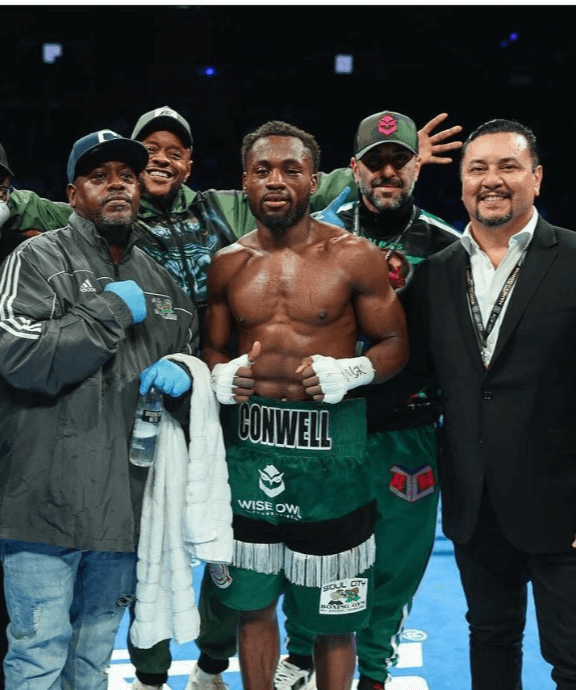
Two below-the-radar super welterweight stars show off their skills this weekend from different parts of Southern California.
One in particular, Charles Conwell, co-headlines a show in Oceanside against a hard-hitting Mexican while another super welter star Sadriddin Akhmedov faces another Mexican hitter in Commerce.
Take your pick.
The super welterweight division is loaded with talent at the moment. If Terence Crawford remained in the division he would be at the top of the class, but he is moving up several weight divisions.
Conwell (21-0, 16 KOs) faces Jorge Garcia Perez (32-4, 26 KOs) a tall knockout puncher from Los Mochis at the Frontwave Arena in Oceanside, Calif. on Saturday April 19. DAZN will stream the Golden Boy Promotions card that also features undisputed flyweight champion Gabriela Fundora. We’ll get to her later.
Conwell might be the best super welterweight out there aside from the big dogs like Vergil Ortiz, Serhii Bohachuk and Sebastian Fundora.
If you are not familiar with Conwell he comes from Cleveland, Ohio and is one of those fighters that other fighters know about. He is good.
He has the James “Lights Out” Toney kind of in-your-face-style where he anchors down and slowly deciphers the opponent’s tools and then takes them away piece by piece. Usually it’s systematic destruction. The kind you see when a skyscraper goes down floor by floor until it’s smoking rubble.
During the Covid days Conwell fought two highly touted undefeated super welters in Wendy Toussaint and Madiyar Ashkeyev. He stopped them both and suddenly was the boogie man of the super welterweight division.
Conwell will be facing Mexico’s taller Garcia who likes to trade blows as most Mexican fighters prefer, especially those from Sinaloa. These guys will be firing H bombs early.
Fundora
Co-headlining the Golden Boy card is Gabriela Fundora (15-0, 7 KOs) the undisputed flyweight champion of the world. She has all the belts and Mexico’s Marilyn Badillo (19-0-1, 3 KOs) wants them.
Gabriela Fundora is the sister of Sebastian Fundora who holds the men’s WBC and WBO super welterweight world titles. Both are tall southpaws with power in each hand to protect the belts they accumulated.
Six months ago, Fundora met Argentina’s Gabriela Alaniz in Las Vegas to determine the undisputed flyweight champion. The much shorter Alaniz tried valiantly to scrap with Fundora and ran into a couple of rocket left hands.
Mexico’s Badillo is an undefeated flyweight from Mexico City who has battled against fellow Mexicans for years. She has fought one world champion in Asley Gonzalez the current super flyweight world titlist. They met years ago with Badillo coming out on top.
Does Badillo have the skill to deal with the taller and hard-hitting Fundora?
When a fighter has a six-inch height advantage like Fundora, it is almost impossible to out-maneuver especially in two-minute rounds. Ask Alaniz who was nearly decapitated when she tried.
This will be Badillo’s first pro fight outside of Mexico.
Commerce Casino
Kazakhstan’s Sadriddin Akhmedov (15-0, 13 KOs) is another dangerous punching super welterweight headlining a 360 Promotions card against Mexico’s Elias Espadas (23-6, 16 KOs) on Saturday at the Commerce Casino.
UFC Fight Pass will stream the 360 Promotions card of about eight bouts.
Akhmedov is another Kazakh puncher similar to the great Gennady “GGG” Golovkin who terrorized the middleweight division for a decade. He doesn’t have the same polish or dexterity but doesn’t lack pure punching power.
It’s another test for the super welterweight who is looking to move up the ladder in the very crowded 154-pound weight division. 360 Promotions already has a top contender in Ukraine’s Serhii Bohachuk who nearly defeated Vergil Ortiz a year ago.
Could Bohachuk and Akhmedov fight each other if nothing else materializes?
That’s a question for another day.
Fights to Watch
Sat. DAZN 5 p.m. Charles Conwell (21-0, 16 KOs) vs. Jorge Garcia Perez (32-4, 26 KOs); Gabriela Fundora (15-0) vs Marilyn Badillo (19-0-1).
Sat. UFC Fight Pass 6 p.m. Sadriddin Akhmedov (15-0) vs Elias Espadas (23-6).
To comment on this story in the Fight Forum CLICK HERE
Featured Articles
TSS Salutes Thomas Hauser and his Bernie Award Cohorts
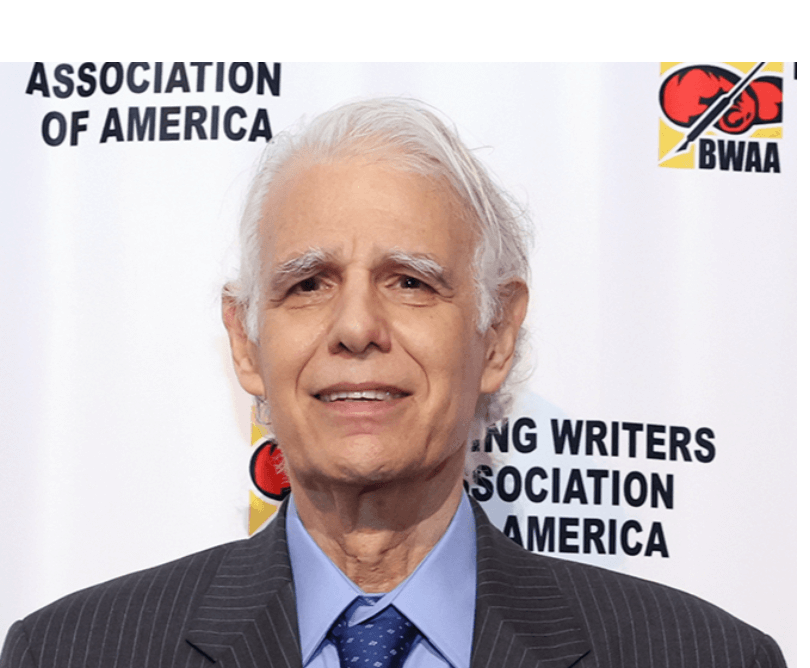
The Boxing Writers Association of America has announced the winners of its annual Bernie Awards competition. The awards, named in honor of former five-time BWAA president and frequent TSS contributor Bernard Fernandez, recognize outstanding writing in six categories as represented by stories published the previous year.
Over the years, this venerable website has produced a host of Bernie Award winners. In 2024, Thomas Hauser kept the tradition alive. A story by Hauser that appeared in these pages finished first in the category “Boxing News Story.” Titled “Ryan Garcia and the New York State Athletic Commission,” the story was published on June 23. You can read it HERE.
Hauser also finished first in the category of “Investigative Reporting” for “The Death of Ardi Ndembo,” a story that ran in the (London) Guardian. (Note: Hauser has owned this category. This is his 11th first place finish for “Investigative Reporting”.)
Thomas Hauser, who entered the International Boxing Hall of Fame with the class of 2019, was honored at last year’s BWAA awards dinner with the A.J. Leibling Award for Outstanding Boxing Writing. The list of previous winners includes such noted authors as W.C. Heinz, Budd Schulberg, Pete Hamill, and George Plimpton, to name just a few.
The Leibling Award is now issued intermittently. The most recent honorees prior to Hauser were Joyce Carol Oates (2015) and Randy Roberts (2019).
Roberts, a Distinguished Professor of History at Purdue University, was tabbed to write the Hauser/Leibling Award story for the glossy magazine for BWAA members published in conjunction with the organization’s annual banquet. Regarding Hauser’s most well-known book, his Muhammad Ali biography, Roberts wrote, “It is nearly impossible to overestimate the importance of the book to our understanding of Ali and his times.” An earlier book by Hauser, “The Black Lights: Inside the World of Professional Boxing,” garnered this accolade: “Anyone who wants to understand boxing today should begin by reading ‘The Black Lights’.”
A panel of six judges determined the Bernie Award winners for stories published in 2024. The stories they evaluated were stripped of their bylines and other identifying marks including the publication or website for which the story was written.
Other winners:
Boxing Event Coverage: Tris Dixon
Boxing Column: Kieran Mulvaney
Boxing Feature (Over 1,500 Words): Lance Pugmire
Boxing Feature (Under 1,500 Words): Chris Mannix
The Dixon, Mulvaney, and Pugmire stories appeared in Boxing Scene; the Mannix story in Sports Illustrated.
The Bernie Award recipients will be honored at the forthcoming BWAA dinner on April 30 at the Edison Ballroom in the heart of Times Square. (For more information, visit the BWAA website). Two days after the dinner, an historic boxing tripleheader will be held in Times Square, the logistics of which should be quite interesting. Ryan Garcia, Devin Haney, and Teofimo Lopez share top billing.
To comment on this story in the Fight Forum CLICK HERE
Featured Articles
Mekhrubon Sanginov, whose Heroism Nearly Proved Fatal, Returns on Saturday
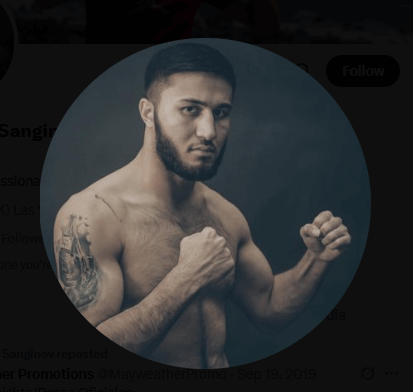
To say that Mekhrubon Sanginov is excited to resume his boxing career would be a great understatement. Sanginov, ranked #9 by the WBA at 154 pounds before his hiatus, last fought on July 8, 2022.
He was in great form before his extended leave, having scored four straight fast knockouts, advancing his record to 13-0-1. Had he remained in Las Vegas, where he had settled after his fifth pro fight, his career may have continued on an upward trajectory, but a trip to his hometown of Dushanbe, Tajikistan, turned everything haywire. A run-in with a knife-wielding bully nearly cost him his life, stalling his career for nearly three full years.
Sanginov was exiting a restaurant in Dushanbe when he saw a man, plainly intoxicated, harassing another man, an innocent bystander. Mekhrubon intervened and was stabbed several times with a long knife. One of the puncture wounds came perilously close to puncturing his heart.
“After he stabbed me, I ran after him and hit him and caught him to hold for the police,” recollects Sanginov. “There was a lot of confusion when the police arrived. At first, the police were not certain what had happened.
“By the time I got to the hospital, I had lost two liters of blood, or so I was told. After I was patched up, one of the surgeons said to me, ‘Give thanks to God because he gave you a second life.’ It is like I was born a second time.”

“I was in the wrong place at the wrong time. It could have happened in any city,” he adds. (A story about the incident on another boxing site elicited this comment from a reader: “Good man right there. World would be a better place if more folk were willing to step up when it counts.”)
Sanginov first laced on a pair of gloves at age 10 and was purportedly 105-14 as an amateur. Growing up, the boxer he most admired was Roberto Duran. “Muhammad Ali will always be the greatest and [Marvin] Hagler was great too, but Duran was always my favorite,” he says.
During his absence from the ring, Sanginov married a girl from Tajikistan and became a father. His son Makhmud was born in Las Vegas and has dual citizenship. “Ideally,” he says, “I would like to have three more children. Two more boys and the last one a daughter.”
He also put on a great deal of weight. When he returned to the gym, his trainer Bones Adams was looking at a cruiserweight. But gradually the weight came off – “I had to give up one of my hobbies; I love to eat,” he says – and he will be resuming his career at 154. “Although I am the same weight as before, I feel stronger now. Before I was more of a boy, now I am a full-grown man,” says Sanginov who turned 29 in February.
He has a lot of rust to shed. Because of all those early knockouts, he has answered the bell for only eight rounds in the last four years. Concordantly, his comeback fight on Saturday could be described as a soft re-awakening. Sanginov’s opponent Mahonri Montes, an 18-year pro from Mexico, has a decent record (36-10-2, 25 KOs) but has been relatively inactive and is only 1-3-1 in his last five. Their match at Thunder Studios in Long Beach, California, is slated for eight rounds.
On May 10, Ardreal Holmes (17-0) faces Erickson Lubin (26-2) on a ProBox card in Kissimmee, Florida. It’s an IBF super welterweight title eliminator, meaning that the winner (in theory) will proceed directly to a world title fight.
Sanginov will be watching closely. He and Holmes were scheduled to meet in March of 2022 in the main event of a ShoBox card on Showtime. That match fell out when Sanginov suffered an ankle injury in sparring.
If not for a twist of fate, that may have been Mekhrubon Sanginov in that IBF eliminator, rather than Ardreal Holmes. We will never know, but one thing we do know is that Mekhrubon’s world title aspirations were too strong to be ruined by a knife-wielding bully.
To comment on this story in the Fight Forum CLICK HERE
-
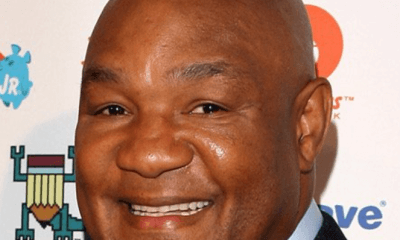
 Featured Articles4 weeks ago
Featured Articles4 weeks agoBernard Fernandez Reflects on His Special Bond with George Foreman
-
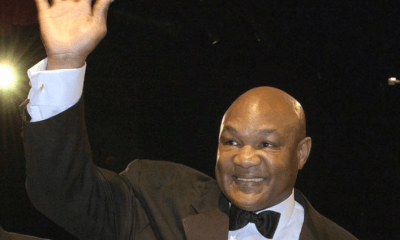
 Featured Articles4 weeks ago
Featured Articles4 weeks agoA Paean to George Foreman (1949-2025), Architect of an Amazing Second Act
-
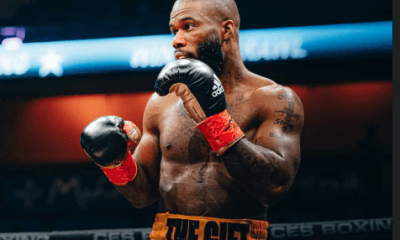
 Featured Articles4 weeks ago
Featured Articles4 weeks agoSpared Prison by a Lenient Judge, Chordale Booker Pursues a World Boxing Title
-
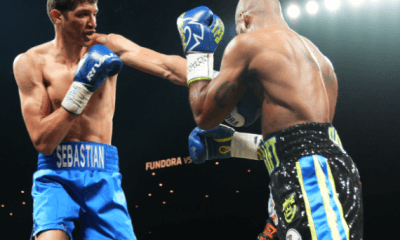
 Featured Articles4 weeks ago
Featured Articles4 weeks agoSebastian Fundora TKOs Chordale Booker in Las Vegas
-
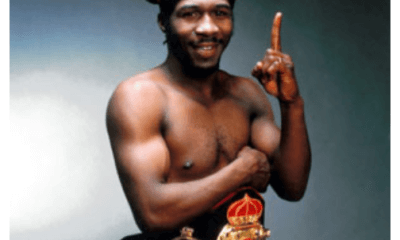
 Featured Articles3 weeks ago
Featured Articles3 weeks agoBoxing Odds and Ends: The Wacky and Sad World of Livingstone Bramble and More
-
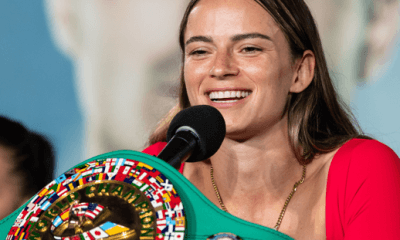
 Featured Articles4 weeks ago
Featured Articles4 weeks agoAvila Perspective, Chap. 318: Aussie Action, Vegas and More
-
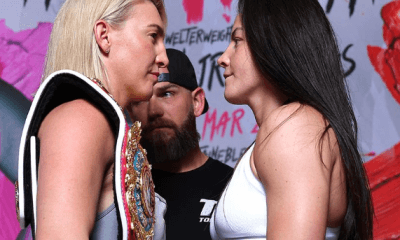
 Featured Articles3 weeks ago
Featured Articles3 weeks agoAvila Perspective, Chap. 319: Rematches in Las Vegas, Cancun and More
-

 Featured Articles3 weeks ago
Featured Articles3 weeks agoRingside at the Fontainebleau where Mikaela Mayer Won her Rematch with Sandy Ryan
















